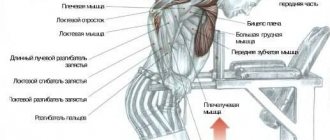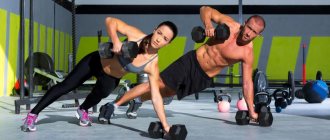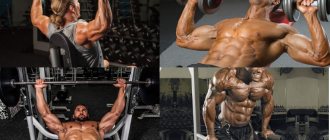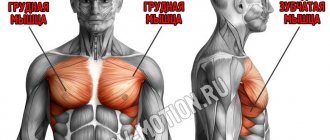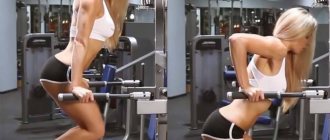12 June 2021 Admin Home page » Tips and tricks
Learn how to add volume to your lower bust area and make your breasts appear more defined and defined. Read 8 important rules and apply them in training!
In most cases, during training, the middle and upper sections of the pectoral muscles are worked out, while the lower one is left without attention and if you train, then with the thought - a couple of times a year is enough, the chest already works hard.
Although the lower part of the pectoral muscles is the first to stand out both on the beach and in a T-shirt, it is the most massive part of the pecs, which gives an attractive view of the torso from the front and emphasizes the strength and health of its owner. Read on to find out how to close the gap in this problem area.
Train the lower area first
Usually, on the day of training the pectoral muscles, visitors, after warming up and stretching, go to the bench press on a horizontal bench, then there is a bench press on an inclined bench with your head up and rarely a third exercise upside down, but dumbbells can also be used. Working in this sequence, devoting only the third exercise to the lower chest, you will spend a lot of energy and the working weight will be greatly reduced.
In the same way, having crossed the threshold of the gym and keeping in mind the goal - how to pump up the lower part of the chest, you should immediately go to the barbell press upside down, making it the first exercise.
This is the only way you can work out your muscles well when you are full of energy and strength, engaging the most dormant muscle areas in the work, do not be afraid to take the weight for 6-8 repetitions, but use the help of a spotter, due to the inconvenience of performing the exercise, it may fall on your neck, oh the consequences of thinking do not need to be said.
Lying push-ups
Perhaps the simplest and at the same time effective exercises at home for the lower part of the pectoral muscles are push-ups. Among them, two types should be distinguished: incline push-ups and deep push-ups. Let us explain how to pump up the lower part of the pectoral muscles at home with push-ups.
To perform incline push-ups, you do not need to have any special equipment, just a bench or chair and your own body. This exercise is performed like this: you need to put your two legs together and lean your hands on the bench, while your body should be straight and not sag in the abdominal area. Then, the athlete bends his arms at the elbows, lowering himself and touching the support with his chest, after which the arms at the elbows straighten and the athlete rises.
While performing the exercise, you should look forward, keeping your head in line with your body and legs. While lowering, you should inhale, and while rising, exhale. Note that the complexity of the exercise depends on the height of the support (the higher, the easier). The width of the arms determines the distribution of the load across the various muscle groups of the upper body; for a good workout of the chest in its lower part, it is recommended to place the arms wider than shoulder width.
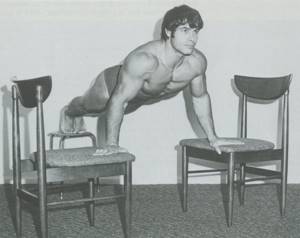
The second type of push-up that is a great exercise for the lower pectoral muscles is the deep push-up. To perform them, you will need special supports, but if they are not at home, then books or any other object that allows you to place your hands higher than the floor surface will do. The idea of the exercise is to increase the load on the chest muscles by lowering the body lower, while bending the elbows more.
2. More exercises for the lower chest
This is the first rule that should immediately come to mind when it comes to pumping up the lower chest.
To do this, you need to pay attention to different exercises from different angles in order to include more muscles in the work and work them from all sides. To do this, use a different angle of negative inclination, set each new exercise at different angles, preventing their repetition.
An example of basic exercises is as follows:
- Head down incline press
- Dumbbell head down press
- Smith machine press with negative incline
- Dips for chest
- Angled push-ups (torso at a 30-degree angle pointing upward)
Training the lower pectoral muscles at home
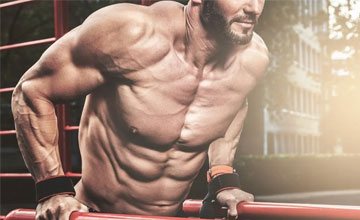
At home, focusing on the lower chest is much more difficult, since this requires doing exercises in a negative tilt, which is impossible due to the lack of a bench.
The only way out will be the bars. But that's not a bad thing. You can build your entire workout around dips and add a few exercises at the end like push-ups and dumbbell pullovers, if you have one, of course.
So, we get the following training program:
- Dips 5 sets of 8-12 reps.
- Close-grip parallel bars, 4 rounds of 8-12 reps.
- Push-ups 5 sets of 10-15 reps.
- Pullover with dumbbells 4 sets of 10-15 reps.
At a certain point, it will become easy for you to do push-ups. Then you can complicate your task in a completely simple way. You can take your backpack, throw something heavy in there and start doing push-ups.
If you don’t have a backpack, then go to the nearest school and start guarding the children. It is advisable to catch those who study in grades 4-7, they have so much stuffed in their backpacks that Thor’s hammer is at rest compared to these backpacks.
He threw the backpack over his shoulders, jumped on the uneven bars, did push-ups, that’s it, beauty. When it becomes easy again, add more weight and do so constantly. To progress, you need to constantly increase the load and give your muscles new stress. Only then will they grow.
Incorporate new exercises
Of course, the arsenal of exercises for targeted pumping of the lower chest is not large, but this should not confuse you with the solution to the question of how to pump up the lower chest. If you have been working in a gym, it’s time to change it to dumbbells and barbells, change the sports equipment every time, change the angles of the gymnastic bench and the back of the exercise equipment, introduce innovations and diversity.
All this will allow the muscles not to get used to the load and cause them to always experience stress, which means they grow.
Lower chest exercises at home
PUSHUPS.
The most accessible exercise that works many muscle groups. It is especially suitable for girls, as it requires minimal skills and its implementation is not too difficult.
To work the lower chest, you need to keep your head higher than your feet. To do this, you can use book stands, increasing their height over time. Place two stacks of books on the floor. Get into the starting position with your feet 15 cm apart, hands on books, palms inward.
You need to move down very slowly and as low as possible. Perform the training very carefully, as books can slip and you can easily injure yourself. You can also use special sports supports as a support; in this case, you can also attach weights.
PUSH-UPS FROM THE BENCH.
Place your hands on the bench with your palms facing inward. Feet apart, back straight. Lower yourself down until your chest touches the bench. You can use a backpack on your back as a weighting device.
PUSH-UPS.
One of the most effective exercises for the lower chest. There are several nuances on how to move the load from your hands to the area you need. When doing push-ups, your torso should be slightly tilted forward and your elbows should be pulled out to the sides, not down.
As you move up, you don't need to straighten your arms all the way. Do the exercise at a measured pace. Over time, you can use weights on your legs.
Push-ups on the horizontal bar.
This load requires experience and skills in push-ups on the horizontal bar. If you are just starting to get acquainted with this equipment, it is better to use a low horizontal bar, approximately at the same level as your head. If you are already a professional, then a regular one will do.
Execution: Place your hands on the horizontal bar at a distance of approximately 25 cm from each other with an overhand grip. You need to forcefully press upward, jumping, and straighten your arms completely. In this case, the lower part of the body should rest against the crossbar. Then you should bend forward slightly and slowly move down, spreading your elbows to the sides. Go as low as possible and repeat.
Push-ups on the uneven bars with emphasis on the chest
Regular parallel bars work great on the chest and triceps, the main thing is to know the correct technique, then you can direct a more targeted load specifically to the lower area, namely:
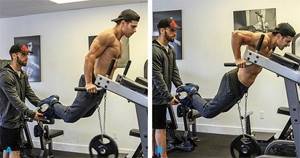
— You need to do push-ups with your body tilted forward, at about an angle of 30-45 degrees. For the first time, you can ask your partner to slightly raise your legs up, which will make it easier to keep your body at an angle.
— During the movement, the elbows should diverge to the sides, and not press against the body, the angle between the body and the elbows is about 45 degrees, this will allow the load to be taken from the triceps and sent to the chest.
— When doing push-ups, do not straighten your elbows completely at the top point, this will allow you to maintain the load in the chest muscles and quickly achieve muscle failure.
Reviews from athletes
All athletes note the effectiveness of push-ups with an incline and depth for developing strength and endurance; in their opinion, these are the simplest exercises for developing the lower part of the pectoral muscles in terms of technique.
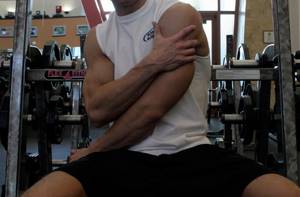
As for training the chest muscles with additional weights (dumbbells, barbells), athletes talk about the need to carefully select the weight of the equipment, as well as a good understanding of the technique of working with it. Otherwise, the risk of injury increases many times over.
Train effectively
Don’t forget that there are many methods for performing approaches, don’t forget about them, but actively implement them:
Negatives - when you are no longer able to lift the barbell or press the levers in the machine, ask your partner to help you push the weight up almost completely, while lowering the weight yourself. Perform it in the last 1-2 sets of the exercise.
The Rest-Pause method breaks the usual approach into smaller ones. For example, you have 8 repetitions in your plan, you did 3 repetitions, returned the bar to the racks and rested for 20 seconds, then again 3 repetitions and rested for 20 seconds, and so on until you pressed at least 2 times.
Drop sets are a great way to increase muscle volume in the short term, by completing the required number of repetitions, quickly lower the weight by 25% and again perform the same number of repetitions as in the first case, and so on, reduce the weight, without resting you get to the empty bar, your chest will fill up and at least for a while you will feel like Hercules.
Training to failure is performing an exercise when, on the last repetition, you feel that the apparatus will simply fall out of your hands due to complete physical and emotional fatigue.
Forced repetitions - involve the help of a partner who slightly helps lift the weight, while the weight is lowered independently without assistance.
The main thing to know is that these methods cannot be used constantly, only from time to time, otherwise the muscles will go into a plateau (stagnation), which means a complete stop in muscle growth.
Adviсe
To achieve a good result, first focus on those parts of the body and muscles that you want to pump up first, only after that start pumping up everything else. This method has already been proven in practice.
Vary your exercises. You don't need to do one exercise all the time, because eventually your progress will stop and your body will stop and you won't get any more results.

Perform insulating loads. This means that working with kettlebells and dumbbells at an incline will give tangible progress in the future.
Constantly add new loads to yourself. Train your body and spirit through pain. Each time, make it a priority to do more than you did yesterday, adding more weight to yourself.
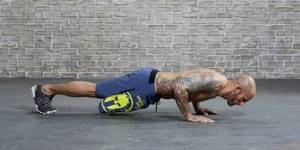
After a hard workout, give your body a good rest. It is at the moment of complete relaxation that the muscles begin their accelerated recovery and begin to grow.
At the end of your workout, do a few sets of parallel bars. This way you can relieve the load from the remaining muscles and give the CNS (central nervous system) a rest.
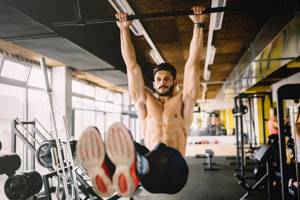
Negatives on the uneven bars at the end of the workout
The basic rules for push-ups are described in paragraph 6, and here you perform a regular push-up.
To do this, lower yourself on the uneven bars for 10 seconds, and immediately, without resting, use your legs to rise up and down again. Do this until you can’t lower yourself for at least 5 seconds, this will put a huge load on your lower chest.
You can use another method: warm up slightly on the uneven bars, put the weight on your belt and only lower your body down, the weight should be decent. You need to lower at a normal pace for 1-2 seconds, but be careful, any incorrect movement can injure the shoulder joint, so this type is only for gym experts.
Dumbbell fly on an incline bench
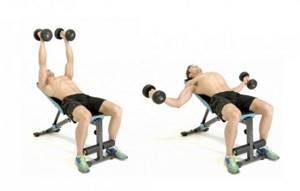
This is the best exercise for the lower pectoral muscles with dumbbells. The inclination of the training bench, as in the previous case, should not exceed 45o. It should be remembered that it is not recommended to use too much weight when performing this exercise, as this can seriously damage the shoulder joint and muscles. The dumbbells are done like this:
- The starting position is completely similar to the starting position when performing a barbell press. The arms are straight, and the palms containing the dumbbells are directed towards each other.
- By spreading your shoulders and bending your elbows, you need to lower the dumbbells so that they are approximately at chest level. While doing this, you should take a breath.
- Exhaling, the athlete returns the projectiles to the starting position by appropriately moving the shoulders and straightening the arms at the elbows.
Recommendations
Anatomically, the major and minor muscles are located on the chest. The first layer is always visible, and the second only performs the function of movement. An increase in breast volume occurs due to a large layer, but it is not recommended to perform a lot of unnecessary training for one group. In order for the pectoral muscles to be bulging, it is necessary to work individual parts. A top that is too voluminous will look saggy, and an untrained bottom will negatively affect the condition of the spine.
In addition to special training, it is recommended to follow a proper diet. Muscles with developed forms, disguised under fat, will not be visible due to training alone. Beginners need to focus on increasing strength and muscle mass. The workouts do not have to be done in the gym; you can choose ones that are suitable for home conditions by studying the thematic video.
It is important to include several different types of loads in the main training that are suitable for both women and men. For example, the basis should include 1-2 basic exercises and 2-3 isolating exercises. For people without experience, it is advisable to first gain total muscle volume, then pump up the lower part of the pectoral muscles.
Tasks for the lower pectoral muscles should be repeated 8-12 times in 3-4 sets; for good pumping, you need to do light stretching at the beginning and at the end of classes.
You can increase the lower pectoral muscles through movements that occur in the direction of the fibers; for this it is necessary to change the angle of execution in some basic tasks. For example, a barbell press is suitable for working the chest, but for the lower part the workout is done upside down.
Alexander Shestov
TRX Certified Trainer
Ask a Question
To avoid injury, it is recommended for a beginner to enlist the support of another person.
Upside down barbell press
To perform, you need a Smith machine, the bench of which is set 25–30 degrees down. The placement is standard, the grip on the barbell is closed, the hands are placed wider than the shoulders, and the feet are on the floor.
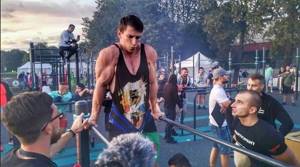
A partner should help remove the bar from the racks, while the projectile moves to the lower chest. From the solar plexus, the barbell is pressed up with an energetic upward movement; you need to pump it up while exhaling, and lower the barbell while inhaling with a smooth movement. The barbell must be held vertically; beating on the chest at the lowest point should be avoided.
